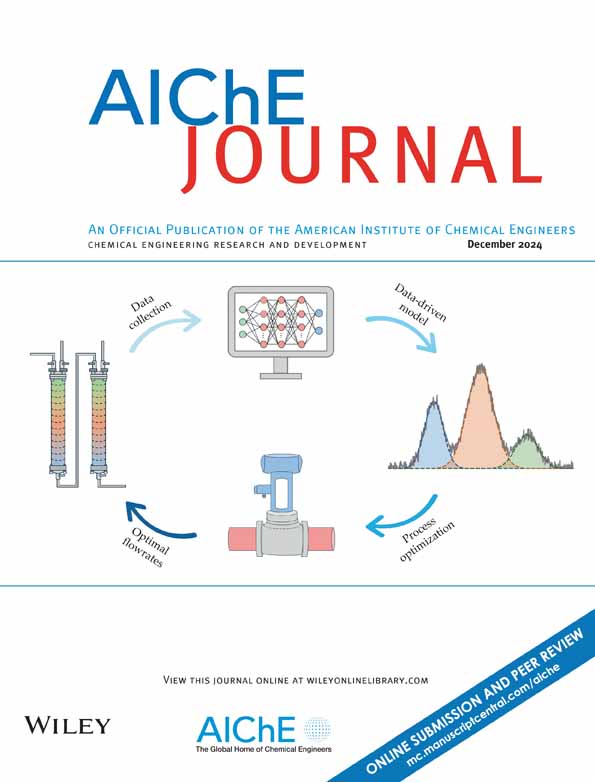Bubble shape classification in a bubble column based on multi-input ConvNeXt model
IF 4
3区 工程技术
Q2 ENGINEERING, CHEMICAL
引用次数: 0
Abstract
A comprehensive understanding of the continuous variation and deformation of rising bubbles is essential for precise reactor scale-up and process optimization. This work combines telecentric vision probe and bubble boundary R-CNN with a newly developed multi-input ConvNeXt to pioneer bubble shape classification under realistic flow conditions. The classification results demonstrate that ellipsoidal bubbles constitute the predominant shape (49.5%), while oblate ellipsoidal bubbles represent the smallest proportions (2.7%). Statistical analysis of E and dm across all classified bubbles reveals significant distinctions: spherical and oblate ellipsoidal bubbles exhibit pronounced differences in E compared to other classes, whereas the remaining shapes show relative consistency. dm varies substantially across classes, progressively increasing in the order: spherical, ellipsoidal, spherical cap, ellipsoidal cap, oblate ellipsoidal, and wobbling ellipsoidal. While our model achieves bubble classification, unresolved issues span image quality constraints, 3D shape inference from 2D data, turbulent flow coupling, and high-velocity applicability—necessitating integrated imaging-algorithm advances.基于多输入ConvNeXt模型的泡柱泡形分类
全面了解上升气泡的连续变化和变形对于精确的反应器放大和工艺优化至关重要。本研究将远心视觉探针和气泡边界R-CNN与新开发的多输入卷积神经网络相结合,在实际流动条件下率先进行了气泡形状分类。分类结果表明,椭球形气泡占主导地位(49.5%),扁椭球形气泡占最小比例(2.7%)。对所有分类气泡的E和dm进行统计分析,揭示了显著的差异:与其他类别相比,球形和扁圆形椭球形气泡的E表现出明显的差异,而其余形状则表现出相对的一致性。不同类别的Dm差异很大,按顺序逐渐增加:球形、椭球形、球形帽、椭球形帽、扁椭球形和摆动椭球形。虽然我们的模型实现了气泡分类,但尚未解决的问题包括图像质量限制、2D数据的3D形状推断、湍流耦合和高速适用性(需要集成成像算法的进步)。
本文章由计算机程序翻译,如有差异,请以英文原文为准。
求助全文
约1分钟内获得全文
求助全文
来源期刊

AIChE Journal
工程技术-工程:化工
CiteScore
7.10
自引率
10.80%
发文量
411
审稿时长
3.6 months
期刊介绍:
The AIChE Journal is the premier research monthly in chemical engineering and related fields. This peer-reviewed and broad-based journal reports on the most important and latest technological advances in core areas of chemical engineering as well as in other relevant engineering disciplines. To keep abreast with the progressive outlook of the profession, the Journal has been expanding the scope of its editorial contents to include such fast developing areas as biotechnology, electrochemical engineering, and environmental engineering.
The AIChE Journal is indeed the global communications vehicle for the world-renowned researchers to exchange top-notch research findings with one another. Subscribing to the AIChE Journal is like having immediate access to nine topical journals in the field.
Articles are categorized according to the following topical areas:
Biomolecular Engineering, Bioengineering, Biochemicals, Biofuels, and Food
Inorganic Materials: Synthesis and Processing
Particle Technology and Fluidization
Process Systems Engineering
Reaction Engineering, Kinetics and Catalysis
Separations: Materials, Devices and Processes
Soft Materials: Synthesis, Processing and Products
Thermodynamics and Molecular-Scale Phenomena
Transport Phenomena and Fluid Mechanics.
 求助内容:
求助内容: 应助结果提醒方式:
应助结果提醒方式:


